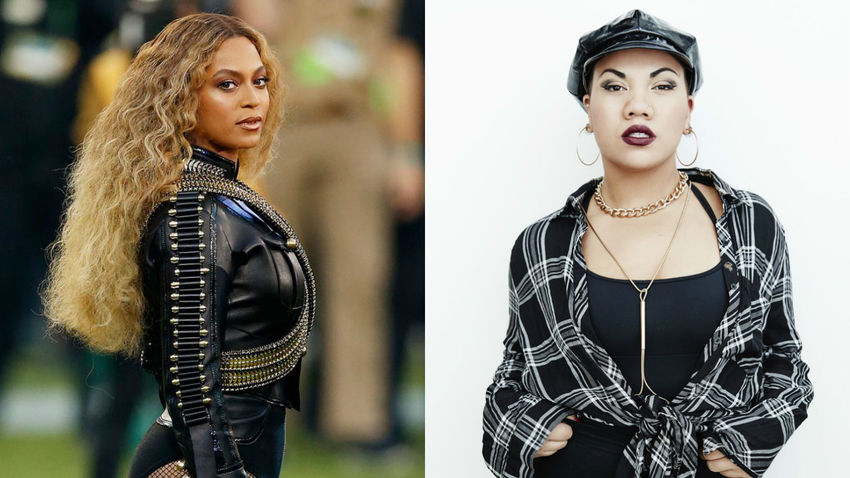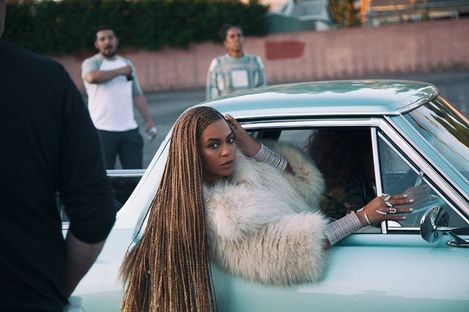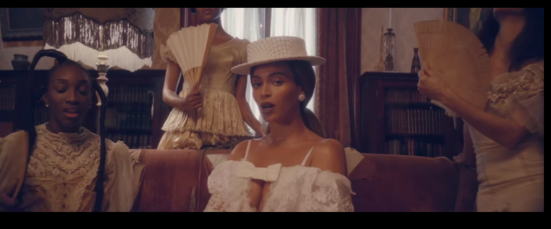Much Furore over Formation

This week two afakasi forces of nature officially slayed online - Beyoncé’s supernova to the masses with ‘Formation’ and Parris Goebel, the superstar to the dance world with her wins at the World Dance Champs in Vegas.
The parallels between these two queens of their domain are many, as they rule and reign their legions of fans, manipulate media and astound the world with the breathtaking extent of their swag.
The internet has gone cray cray with arguments over Beyoncé’s statements of blackness / mixed raceness / should she be repping Katrina-ness.

While there is an obvious ‘invisible passport’ that both these women have as afakasi’s and the privilege that goes with the ‘high yella’, the power they negotiate through their cleverly wrought images works the confrontation of their ethnicity to the forefront. They have passed the commercial margins of ‘crossover’ whiteness but throw the swag of their blackness back out there - Beyoncé through her imagery and Parris through the notoriety of her ‘PolySwag’
But they share more than the ‘F* you’ confidence that is thrown with a haughty head flick. Their styling, stance and visuals of choice has a history that connects these women of colour from the South Pacific and the deep South through time and geography.
Of all these great convos, one that strikes home for me as a watered down woman of colour in the Pacific, is the common notion of Beyoncé being ‘too white for the blacks and too black for the whites’
This has long been the catch cry of the afakasi of any and many colours, and coupled with many of the powerful imagery and emotions she invokes in Formation there is a strong resonance in the video for many Pacific women.
The afakasi history of disturbance and confrontation in Samoa in particular, is one that has been written about extensively by Dr Damon Salesa in this thesis ‘Troublesome Half-castes’ based on a German doctrine in the colonial era.
The couple of thousand half-castes (out of a population of some 30,000) were stamped with a particular identity in official eyes. They were inappropriate leaders with selfish and modern motives, leading natives astray. Worse, they compromised the social and political distance which colonial governments desired.*
It seems that ‘troublesome half-castes’ are still leading natives astray, in the most powerful arena of all - popular culture.
The light skinned aphrodite's of the South Seas and the mulattos and quadroons of the deep South have interesting ties in the ways their legendary exoticism and the romantic hankering for their image has persisted into modern day popular culture.
Half-castes were born of a 'queer magic', as Noel Coward called it, children of natural human desires, yet often treated as unnatural; left in a position which could attract both envy and disdain.*
The Formation video is laden with so many images of black women that are signifiers we have witnessed in so much other popular culture, including our own Pacific culture. Like the legendary allure of the dusky maiden, the Creole women of colour were the exotic beacons of beauty who drew in the gaze and the wealth of white men to further their livelihoods as a mechanism of survival.

While Pacific dusky maidens didn’t have the legacy of slavery to combat in the same way, negotiating status in the white colonial strata of Samoa in the early 1900’s was still fraught for the afakasi sector whose access to education and economy relied in being able to be classed as ‘European’.
It’s not like the struggle wasn’t a nuclear bomb more real for full blooded women of colour, but the ability for the afakasi class to infiltrate the status quo and negotiate the first positions of power for ‘coloured-ness’ without given up their end game is a thing.
Free women of colour in Louisiana have made one of the most influential marks in the history of coloured women around the globe. As a movement the gens de couleur libres in New Orleans in particular were some of the first coloured women to have financial, personal and political power and have huge influence over generations of the slave population.
Negotiating a space for themselves in the pre civil war race-torn South relied on the priviledge of their white bloodlines and exotic looks, but as the first coloured women to make their mark in white societies their story has always fascinated.
A movement that developed from the slave concubine period, these women were set up to be mistresses of white men, often having contracts negotiated for them by their mothers. High class prostitutes, ‘tragic mulattos’, the belles of New Orleans society the tags are many for this complex group that became a thriving social class in the early 1800’s.
‘Under the system of plaçage, often the mothers negotiated a kind of dowry or property transfer to their daughters, including freedom for them and their children, and education for the children. The French Creole men often paid for education of their "natural" (illegitimate) mixed-race children from these relationships, especially if they were sons, generally sending them to France to be educated.’**
The free women of colour in this time were notorious for having some education, colourful social lives, being seamstresses of exquisite style, and the exotic beauties of the time.
Free women of color could and did accumulate wealth and invest in property—land, homes, and stores. By buying, selling, and renting real estate, or by purchasing and leasing slaves, they guaranteed themselves a regular income.They formed a social category distinct from both whites and slaves, and maintained their own society into the period after United States annexation. ***
Many were artisans who owned property and their own businesses.
The extraordinary balancing act that this often exploited and vulnerable group has to constantly negotiate is extensively documented and the ways that many of these women were allowed to prosper was through the system of place where they became mistresses of white men.
Historian Dr Emma Clark writes “The system of slavery depended on a pair of binaries: slave or free, black or white. Mixed race people challenged that binary at every turn, and still do. I think that one of the reasons that free women of color are absent from the history taught in schools” ****
Yet still the romanticised image of the beautiful Creole who was able to flaunt her beauty sexuality, style and wealth in the face of extreme white oppression clocks one up for the sistren, and is referenced strongly in ‘Formation’ and in Beyonce herself.
The messages around their imagery and behaviour is clearly un-assimilating - ‘we will revel in our coloured-ness’.
The idea of the exotic queens of the ‘quadroon balls’ referenced in Formation also echo in similar imagery of the dusky maiden in the Pacific.

Here too is a history of the lighter skinned women of colour sought after by white men, who managed to negotiate their fates and fortunes through careful exploitation of their situation.
Carefully crafted captured images of the Pacific female exotic are staged to be frozen in time on some mantlepiece in England.
But the eyes, the gaze, the tilt of the head. In so many of these images you beg for their unspoken story.
Queen Emma is perhaps the most legendary afakasi women to have made fame and fortune from her mixed blood legacy, business accumen, beauty and style. Her outrageously flamboyant lifestyle, colourful personality and self made wealth in the early 1900s marks her as a one of the region’s most notorious Pacific women who lived her life on her own terms and left a huge legacy for Samoan women to follow.
Flamboyant beautiful rich defiant and controversial - again the echoes ripple across time and space to modern day ‘afakasidom’ of Beyonce and her Samoan sistah Parris Goebel.
While Parris doesn't employ a consciously political subtext in the same obvious way as Formation, her visual language expands way behind the hip hop realm into a blatantly confrontational sexuality that literally shakes her ass at the global audience. She creates a new brown girl iconography in place of the black hip hop queens before her.
Unconventional, divergent, troublesome.
The ‘troublesome half-castes’ as coined by Dr Damon Salesa in his reference to a German doctrine on Samoans in the colonial era, were a group similarly to the gens de coleur libre who gained the first glimmers of commercial and political power in Samoa and were a group often marked by their economic privilege.
The afakasi history is long and complex, and similarly to the gens de coleur libre is rife with the problems of struggling with class acceptance, assimilation into white society, and the long standing history of fighting for Samoan autonomy. The face of the Mau movement lead by afakasi merchant Olaf Nelson meant he was able to access to legal, economic and social positions of power that helped the resistant movement to flourish.
Like with any imagery in the all encompassing powerful medium of the screen big or small, it always comes down to who’s telling the story and who is being told too?
These women of colour from another age still win, because even in their Victorian trappings, entrapped in the fantasy of the photographer, painter, male viewer their image manages to speak volumes of stepping into the liminal borderland space of the Other and having some modicum of power there.
Beyoncé re-claiming of the inherent power in the mulatto and quadroons of yesteryear, Parris Goebel’s gaze back, slap down and owning of the latent day dusky maiden, speaks in crescendo to coloured women who may not agree with it but are at the very least - being spoken to.
They both position the coloured narrative at the center and not the periphery by sheer virtue of their in- your- face swag, this is the story that is being thrust at the mainstream.
The sexuality of coloured women has long been the sizzle that sells the sausage, here the sizzle is burning down the house owned and slam dunked by these afakasi’s who are ruling their separate worlds.
#TROUBLESOMEHALFCASTES
______________________________________________________________________________________
* Damoan Salesa ‘Half-castes between the Wars’ NZ Journal of History 34’ Pg 98 http://www.nzjh.auckland.ac.nz/docs/2000/NZJH_34_1_08.pdf
** 1855 Free People Of Colour By The Times-Picayune http://www.nola.com/175years/index.ssf/2011/08/1855_free_people_of_color_flou.html
*** ‘Free People of Color and Creoles’ Gregory Osborn
**** Dr Emily Clark in Mystery of free women of color unraveled’ Mary Ann Travis
